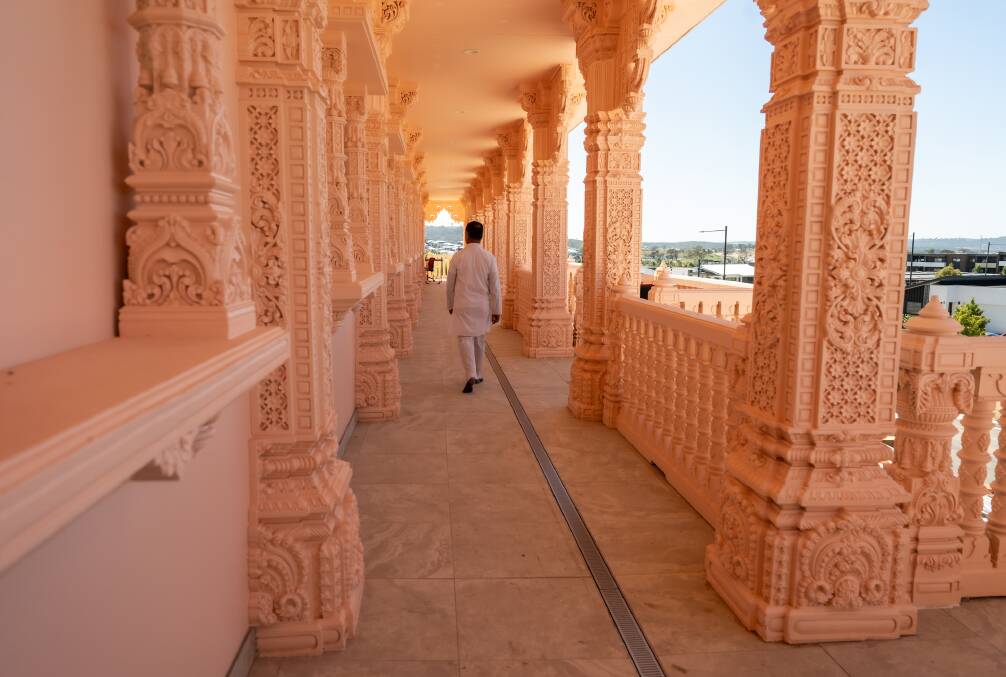A decade of patience and sacrifice has borne fruit in the form of a striking shrine for one of Canberra's Hindu communities.
The eye-catching structure in Taylor was completed in just over 18 months to serve as a temple and community centre for members of socio-spiritual group Bochasanwasi Shri Akshar Purushottam Swaminarayan Sanstha (BAPS).
University student Drashti Patel was one of many volunteers who donated much of their time and income to bring the community's vision to life.
"It's kind of like a second home. I come here almost every day," the 20-year-old said.

While traditional Indian temples are usually made of stone carved by hand, and take several years to complete, this temple is among those in Australia assembled using ornamental facades made from reinforced glass and concrete.
Nevertheless, the BAPS Shri Swaminarayan Hindu mandir (temple) is etched throughout with classical meanings.

"In Hinduism, we believe a temple to be like the living form of God, God's body," Ms Patel said.
"The spires on the top which are called shikharas are the shoulders of God. On top of the spires, the golden vessel is the neck, and the red and white flags represents devotion and purity."
A grand opening
As Hindus worship hundreds of millions of gods and goddesses, the temple will be home to at least 13 divine figures, including deities and gurus, to serve a range of followers in Canberra.
The BAPS group is preparing to reveal the shrine and statues in a grand opening festival in March. About 2000 devotees have already registered for the four-day event.
Volunteers said guests would be served three meals a day prepared by volunteers in their kitchen team.
The event's religious rituals will include a Vishwa Shanti Mahayagna (praying for world peace, unity) and the Nagar Yatra (carrying resident gods on a palanquin around the neighbourhood to show them to their new homes).

The creamy-coral, two-storey structure stands on more than 6800 square feet of land at the corner of Robin Boyd Crescent.
The temple can comfortably accommodate 500 people in its main hall with more space in its 10 rooms.
Not just a temple
The building has a commercial kitchen bigger than most restaurants, two separate dining areas, a snack shop, a parents room, six rooms with white boards where children are taught Gujarati as well as traditional dance and music.
It also has living quarters for visiting monks and a temple caretaker.

The temple is fully funded by BAPS volunteers.
Children saved their allowances, held bake sales and returned recycled cans to raise $35,000, while adults sold investment properties to raise additional funds.
Members feel it was all worth it after four years of having to squeeze 120 to 250 devotees into school and community halls for their weekly assemblies.
"We were at Ngunnawal Primary School, we would hire the facilities there every Sunday. It was a really great place and we're so grateful to them for keeping us there for eight years," Ms Patel said.
'We are one family'
Naresh Patel's journey has been "up and down", but it's clear how much the temple and community centre means to the volunteer.
He recalls talks of wanting to build a mandir when he first move to Canberra in 2016.
Ever since, he's been a regular at assemblies while putting aside much of his time and money towards the completion of the project.
However, he was unexpectedly diagnosed with a brain tumour in 2022 and remembers thinking he needed to go to India for treatment.

"I told one of our volunteers ... and the only message I got was, 'don't worry, we are one family'. So I could have done my surgery in India where I had only two families. But I had the support of 50 families here. I went for my surgery to Canberra hospital," Mr Patel told The Canberra Times.
A spokesperson said he volunteered tirelessly until the day before his surgery.
Everyone is welcome
Drashti Patel said the temple was more than a place of worship. She said it was a place of learning for young people, a place for celebration, collaboration and forging new bonds with the wider community.
Ms Patel wanted people to know the mandir was open to anyone regardless of their faith or background.

"We say that a temple is kind of like a place for the soul ... where we can disconnect from worldly things and all the problems we have there," she said.
"Think about yourself and your connection with God. You might not be a religious person, but any temple provides a sense of peace that you can't really get anywhere else.
"That's helpful for anyone despite what their religion is, it's a place for your soul and a soul does not have religion or a race."







